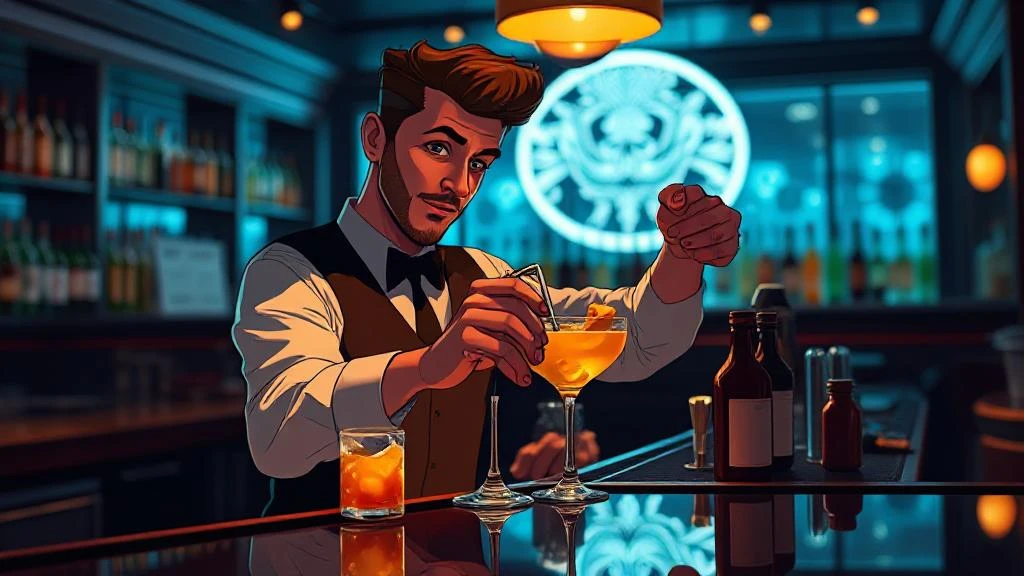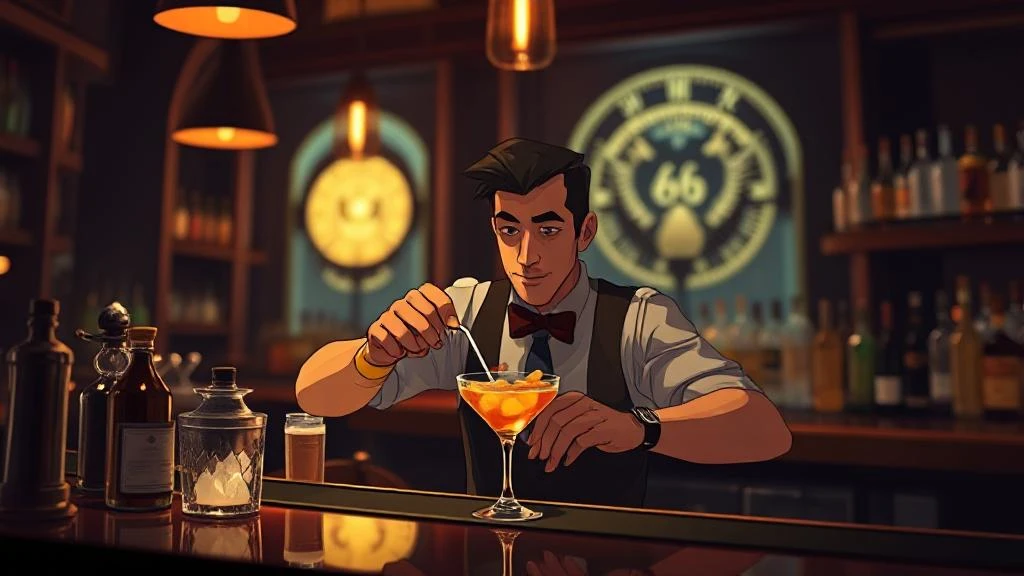Harry Craddock (August 29, 1876 – January 25, 1963) was an English bartender who became one of the most influential figures in cocktail history.
As the head bartender at the prestigious Savoy Hotel’s American Bar in London from 1926 to 1938, Craddock established himself as a master mixologist whose creations continue to inspire bartenders worldwide.
Known as “the dean of cocktail shakers,” Craddock’s precise techniques and innovative approach to mixology earned him international acclaim.
His legacy includes numerous classic cocktails still enjoyed today and his legendary cocktail recipe collection, The Savoy Cocktail Book, which remains an essential resource for bartenders and cocktail enthusiasts nearly a century after its publication.
Background & Journey
Born in Stroud, Gloucestershire, England, Harry Craddock left his homeland at age 21, seeking better opportunities in America. His bartending journey began in the United States, where he honed his craft at some of the country’s most prestigious establishments.
Craddock worked at Cleveland’s Hollenden Hotel before moving to New York, where he tended bar at the famous Hoffman House and the Knickerbocker Hotel. His skills and personality made him popular with high-society patrons, allowing him to master the increasingly fashionable American cocktail style.
In 1916, Craddock became a naturalized American citizen. However, when Prohibition took effect in 1920, his career faced a significant turning point. Rather than abandon his craft, Craddock returned to England, reportedly claiming to have mixed “the last legal cocktail in America” before departing.
Upon arriving in London, Craddock quickly landed a position at the Savoy Hotel’s American Bar. His American accent, experience, and knowledge of American-style cocktails—featuring strong spirits, multiple ingredients, and the novel use of ice—made him a perfect fit for the establishment. By 1926, he had been promoted to head bartender, succeeding Ada “Coley” Coleman.
Signature Style & Philosophy
Craddock approached mixology with scientific precision and artistic flair. He believed in the transformative power of a well-crafted cocktail and its ability to enhance social experiences. His style was characterized by impeccable balance and elegant simplicity, often creating complex flavors with relatively few ingredients.
A master of gin cocktails, Craddock helped popularize this spirit during a time when it was gaining prominence. He was particularly adept at finding perfect harmony between spirit, citrus, and sweetening agents, creating drinks that were refreshing yet sophisticated.
Craddock was fastidious about his techniques, believing that the method of preparation was as important as the ingredients themselves. He was known for his precise measuring, proper dilution through stirring or shaking, and careful attention to temperature and presentation. This methodical approach reflected his philosophy that bartending was both a science and an art form deserving of respect and dedication.
Signature Cocktails
During his illustrious career, Craddock created or popularized numerous cocktails that have become classics in the mixology world. These signature creations showcase his talent for balance and innovation:
The White Lady
Perhaps Craddock’s most famous creation, the White Lady combines gin, Cointreau, and fresh lemon juice in perfect harmony. This elegant cocktail demonstrates Craddock’s ability to balance a spirit-forward drink with citrus brightness. The White Lady was so significant to Craddock that in 1927, during renovations at the American Bar, he buried a cocktail shaker containing this concoction in the walls—a time capsule that reportedly remains there to this day.
Corpse Reviver No. 2
This legendary “hair of the dog” remedy exemplifies Craddock’s wit and skill. Combining equal parts gin, Lillet Blanc, Cointreau, and lemon juice, with a dash of absinthe, the Corpse Reviver No. 2 was intended as a morning pick-me-up. Craddock famously warned in his cocktail book that “four of these taken in swift succession will un-revive the corpse again,” demonstrating his humorous approach to serious mixology.
Corpse Reviver No. 1
Less famous than its successor but equally impressive, this cognac-based cocktail features cognac, Calvados (apple brandy), and sweet vermouth. Craddock noted it was “to be taken before 11 a.m., or whenever steam and energy are needed,” showing his understanding of cocktails as functional as well as pleasurable.
The Hanky Panky
While Ada Coleman created this cocktail, Craddock helped preserve and popularize it by including it in The Savoy Cocktail Book. This sophisticated combination of gin, sweet vermouth, and Fernet-Branca showcases Craddock’s appreciation for complex flavors and his respect for his predecessor’s contributions to the craft.
Industry Contributions
Craddock’s most enduring contribution to cocktail culture is undoubtedly The Savoy Cocktail Book, published in 1930. This comprehensive collection of 750 cocktail recipes preserved many drinks that might otherwise have been lost to history and established standards for cocktail creation that continue to influence bartenders today.
Beyond his book, Craddock co-founded the United Kingdom Bartenders’ Guild in 1934, helping to professionalize and elevate the status of bartending as a craft. This organization continues to promote excellence in the industry.
As a master of publicity, Craddock understood the importance of performance in bartending. He was immortalized in wax at Madame Tussaud’s and would announce his return from annual holidays in the personal column of The Times newspaper, demonstrating an early understanding of personal branding.
Craddock also contributed to cocktail culture through his innovative techniques, including what would later be known as the “dry shake” method for creating cocktail foam, and by popularizing ingredients like Cointreau and absinthe in his creations.
Related Industry Figures
Craddock’s career intersected with several other important figures in cocktail history. Ada “Coley” Coleman, his predecessor at the Savoy’s American Bar, was a pioneer as one of the first female head bartenders at a prestigious establishment and the creator of the Hanky Panky cocktail.
Harry MacElhone, a contemporary of Craddock’s who ran Harry’s New York Bar in Paris, was another influential figure with whom Craddock shared a professional rivalry and mutual respect. Both men contributed significantly to cocktail literature and culture during the same period.
William J. Tarling, a colleague who succeeded Craddock at the UK Bartenders’ Guild, continued his work of preserving and advancing cocktail culture through his own book, the Café Royal Cocktail Book.
Jerry Thomas, “the father of American mixology,” preceded Craddock but set the stage for his success by establishing bartending as a respected profession worthy of documentation. Craddock built upon this foundation to further elevate the craft.
Legacy & Influence
After his tenure at the Savoy, Craddock moved to the Dorchester Hotel in 1938 and later to Brown’s Hotel in Mayfair, where he worked until his retirement in 1947. Despite his significant contributions to cocktail culture, Craddock died in 1963 and was buried in a pauper’s grave, a sad end for such an influential figure.
However, his legacy lives on through his recipes and the bartenders he has inspired across generations. Today, The Savoy Cocktail Book remains in print and is considered one of the most important cocktail texts ever published. Bartenders worldwide still reference his techniques and recipes, often putting their own spin on his classic creations.
The craft cocktail renaissance of recent decades has brought renewed attention to Craddock’s contributions. Modern bartenders continue to honor his memory by preserving his recipes and approach to bartending as an art form that combines technique, knowledge, creativity, and hospitality.
As we raise our glasses today, we toast not just the flavors in our cups but the legacy of Harry Craddock—a bartender whose passion, innovation, and dedication helped shape the cocktails we enjoy nearly a century later. What’s your favorite Craddock creation? Have you tried mixing one of his classics at home?











